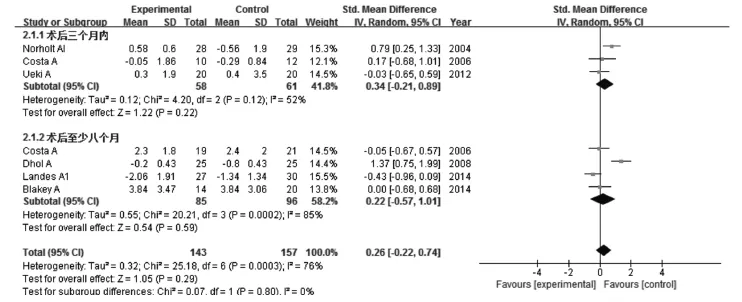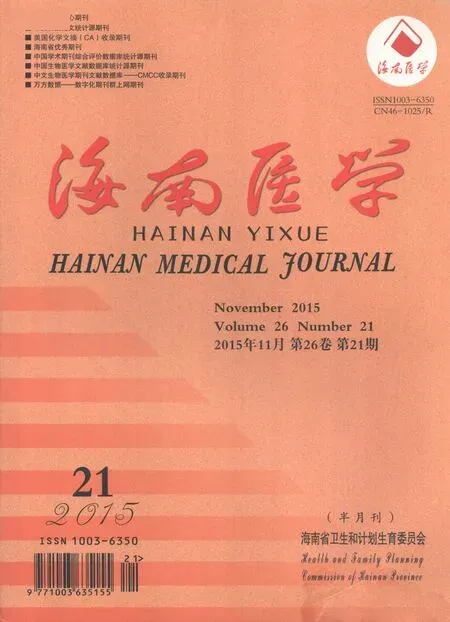可吸收材料内固定与钛合金内固定对正颌术后骨稳定性的Meta分析
贺娇娇,刘 畅,王春晖,王思涵,郭小凯
(吉林大学口腔医学院正畸科,吉林 长春 130021)
可吸收材料内固定与钛合金内固定对正颌术后骨稳定性的Meta分析
贺娇娇,刘 畅,王春晖,王思涵,郭小凯
(吉林大学口腔医学院正畸科,吉林 长春 130021)
目的评价可吸收材料内固定与钛合金内固定对正颌术后的骨稳定性。方法计算机检索2004-2014年PubNed、Cochrane Library、Embase数据库,收集可吸收材料内固定与钛合金内固定在正颌外科应用的各类对照性研究,提取文献数据及质量评价后,用RevMan5.3软件进行系统评价,比较两者在BSSRO和Le Fort I术后水平向和垂直向的骨稳定性。结果共有10篇文献纳入研究,Meta分析结果显示两者在BSSRO和Le Fort I术后水平向和垂直向有相似的骨稳定性,差异均无统计学意义(P>0.05)。结论可吸收内固定材料与钛合金比较,两者在正颌术后均可提供相似的骨稳定性。由于该系统评价纳入研究的样本量较小,原始研究质量较低,且有中度偏倚风险,需要更多高质量、大样本的随机对照试验提供更可靠的证据,建议临床严格把握适应证,选择合适的内固定材料。
可吸收;正颌外科;骨稳定性;Meta分析
在过去的25年里,钛合金内固定系统一直作为正颌外科内固定材料的“金标准”,这种金属材料具有高度的生物相容性、抗腐蚀性,吸引了广泛的关注和应用[1-2]。然而,金属材料长期留置体内,各种潜在的副作用包括局部冷热刺激敏感、可触及性、金属离子释放、化学致癌性、感染等导致其移除的比例达5%~40%[3-5]。钛合金内固定系统的有限性促进了新型生物可降解材料的加工,避免了二次手术,减轻了患者的心理压力及经济负担。虽然许多研究表明可吸收内固定材料在术后稳定性及复发性方面显示与钛板钛钉相当的效果,但其临床应用尚不够广泛[6-7]。此研究拟通过Meta分析比较两组在正颌术后水平向和垂直向的骨稳定性,为临床提供循证医学证据。
1 资料与方法
1.1文献检索 本文依据系统评价和荟萃分析优先报告的条目PRISMA声明而写。计算机检索PubMed、Cochrane Library、Embase数据库,时间为2004-2014年。检索词为:bioabsorbable screws、titanium osteosynthesis、resorbable plate、biodegradable osteofixation、poly-L-lactic acid(PLLA)、PLLA/PGA、poly-L-lactic acid and polyglycolic acid;poly-L/DL-lactic、PLLDL、orthognathic surgery、skeletal stability。
1.2 纳入标准及排除标准
1.2.1 纳入标准 (1)研究类型:国外已发表或未发表的可吸收材料内固定与钛合金材料内固定在正颌术后骨稳定性的对比性临床研究(CCT),随机对照研究(RCT)和回顾性对照研究(RS)。(2)研究对象:性别不限,年龄13~50岁,通过查体及影像学检查诊断为颌骨发育缺陷,下颌后缩畸形或前突,上颌发育不全等,需正颌手术(BSSO双侧矢状劈开术、Le Fort I型截骨术或两者同时实行)。(3)干预措施:实验组行可吸收材料内固定,包括PLDLA、PLLA/PGA、PLLA等材料。对照组行钛合金材料内固定。(4)结局指标:随访后水平向和垂直向骨性标志点的移动程度,包括线性和角度性参数。
1.2.2 排除标准 (1)病例或技术报道;(2)动物研究;(3)综述类文章;(4)无对照组;(5)测量结果无可用作Meta分析的数据;(6)同一作者的不同研究,有相同的数据;(7)非英语类文章。
1.3 资料提取 通过阅读文题、摘要,按纳入排除标准筛选检出文献,意见不一致时通过讨论或咨询第三方解决。提取纳入文献中相关的数据并编号,对年份、作者、刊名等资料设盲后提交两名分析者独立进行数据统计,缺乏的资料通过与作者联系补充。
1.4 质量评价 质量评估结合了流行病学观察性研究的Meta分析标准(MOOSE)[8],加强观察性流行病学研究报告的质量评估SROSES[9]以及PRISMA[10]。偏倚风险的评估基于以下5个指标:病例随机分配,研究对象有明确的纳入和排除标准,报道失访退出,有效的测量值,统计学分析。若该研究满足以上所有标准,则为低偏倚风险。若以上指标只有一项不能满足,则为中等偏倚。若有两项不能满足,则有高度偏倚风险。
1.5 统计学方法 采用Rev Man5.3软件进行Meta分析。采用χ2检验分析各研究间的统计学异质性,P<0.10,I2>50%时,为差异有显著统计学意义[11]。异质性检验结果显示差异无显著统计学意义时,采用固定效应模型进行Meta分析;反之,采用随机效应模型合并效应量。
2 结 果
2.1 文献检索结果 初步检索出相关文献106篇。阅读题目及摘要后筛选出32篇,经两名研究者根据纳入、排除标准,阅读全文后最终纳入10项研究[12-21]。患者共478例,其中可吸收材料内固定组243例,钛合金内固定组229例,见图1。

图1 文献筛选流程及结果
2.2 纳入研究的基本情况和方法学质量评价 纳入研究的基本情况见表1。7项研究对比了BSSRO术后两组的骨稳定性,3项行下颌前徙术,其中1项单独行下颌手术,2项行双颌手术。4项行下颌后退术,均为双颌手术。总计6项研究做了Le Fort I术后骨稳定性评价,其中4项做了双颌手术,1项单独做Le Fort I型上颌前移术,1项行上颌压低结合或不结合下颌的手术。依据质量评价,总计2项随机对照研究,有低度偏倚风险。3项回顾性研究,5项临床试验对照研究,均有中度偏倚风险,见表2。
2.3 统计分析结果
2.3.1 BSSRO术后可吸收内固定组与钛合金内固定组下颌参数的变化
2.3.1.1 角度参数-SNB角的变化 共纳入3个研究[13,16-17],112例患者(可吸收组n=55,对照组n= 57)。随访时间为3个月~1年,两组比较差异无统计学意义[SMD=-0.04,95%CI(-0.41,0.33),P=0.84],各研究间无统计学异质性(P=0.82,I2=0%),如图2。
2.3.1.2下颌前移后两组水平向线性参数(B点,Pg点)的变化 共纳入3个研究[14,19-20],患者165例(可吸收组n=62,对照组n=76)。随访时间≥1年,两组间比较差异无统计学意义[SMD=0.13,95%CI(-0.55,0.81),P=0.71],各研究间无统计学异质性(P=0.38,I2= 4%),见图3。

表1 纳入研究的基本情况

表2 纳入研究的质量评价

图2 BSSRO术后两组SNB角变化的森林图

图3 BSSRO术下颌前移后两组水平向线性参数变化的森林图
2.3.1.3下颌后退后两组水平向线性参数(B点,Pg点)的变化 共纳入4个研究[13,17-18,20],患者128例(可吸收组n=66,对照组n=62)。随访时间3个月~1年,两组间比较差异无统计学意义[SMD=0.05,95% CI(-0.31,0.40),P=0.80],各研究间无统计学异质性(P=0.58,I2=0%),见图4。

图4 BSSRO术下颌后退后两组水平向线性参数变化的森林图
2.3.1.4 术后两组垂直向线性参数(B点,Pg点,Me点)变化 共纳入5个研究[13-14,16-17,19],患者218例(可吸收组n=104,对照组n=114)。随访时间3个月~1年,两组间比较差异无统计学意义[SMD=0.05,95%CI(-0.15,0.24),P=0.64],各研究间存在显著异质性(P=0.0006,I2=71%),因此选择随机效应模式,见图5。
2.3.2 Le Fort I术后两组上颌参数的变化
2.3.2.1上颌前移后水平向线性参数(A点、AI点)的变化 共纳入6个研究[12-13,15,18,20-21],患者278例(可吸收组n=133,对照组n=145)。随访时间分为3个月内和至少8个月后,两个时间段内组间比较差异无统计学意义[SMD=0.26,95%CI(-0.22,0.74),P=0.29]。各研究间存在显著异质性(P=0.000 3,I2=76%),故选择随机效应模式,见图6。
2.3.2.2 上颌压低后垂直向线性参数(A点、AI点)的变化 共纳入5个研究[12-13,15,18,20],患者192例(可吸收组n=95,对照组n=97)。随访时间分为3个月内和至少8个月后,两个时间段内组间比较差异无统计学意义[SMD=-0.41,95%CI(-1.07,0.25),P=0.22],各研究间存在显著异质性(P<0.000 1,I2=81%),故选择随机效应模式,见图7。

图5 BSSRO术后两组垂直向线性参数变化的森林图

图6 Le Fort I术后两组上颌前移水平向线性参数(A点,AI点)变化的森林图

图7 Le Fort I术后两组上颌压低垂直向线性参数(A点、AI点)变化的森林图
3 讨论
Kiely等[22]和Turvey等[23]分别报道了在面临着钛合金材料和可吸收内固定材料的选择时绝大多数患者选择了后者,可见可吸收内固定材料在正颌患者中广受欢迎,并且近十年来在这方面发表的文章不断增加,研究可吸收内固定材料的国家和作者数目也逐渐增多。但关于与该种材料在正颌术后的骨稳定性,尚缺乏系统性评价。正颌手术的术式主要包括双侧下颌支矢状骨劈开术(BSSRO)、Le Fort I型截骨术、双颌手术、颏成形术等。本研究主要选择行BSSRO、Le Fort I型截骨术或双颌手术的病例。
3.1 BSSRO术后稳定性评价 本研究主要比较了两组术后SNB角、水平向和垂直向线性参数(B点、Pg点、Me点)的变化,结果显示组间差异并无统计学意义。但多数研究表明下颌前移术中移动距离较大时两组的复发程度均明显增加。Ballon等[24]和Proffit等[25]表明下颌后退(Setback)术后,不论用哪种内固定材料稳定性均切欠佳,复发程度较大。一者可能是下颌后退术后,舌体被推向更靠后的位置,舌体压迫下颌骨推之前移;其次可能是术中髁突位置变化导致术后下颌位置改变。但也有研究也表明两组术后的稳定性均较好,复发程度亦无显著性差异[20,26]。
3.2 Le Fort I型截骨术术后稳定性评价 本文主要选择了Le Fort I型截骨术术后上颌骨性标志点在垂直向和水平向的变化。结果示两组并无显著性差异。但各研究间存在较大的异质性,可能是各项研究采用了不同的可吸收材料。除了内固定材料外,还有其他多种因素会影响术后的骨稳定性,如不同的术式、不同的骨质厚度、不同的术后咬合板固定、颌间牵引及各骨段间的应力分布、医师依据患者情况不同的过度矫治程度等。再者,多种因素因素影响术后稳定性的判定,如性别、年龄、不同的投影测量技术、不同或者不精确的骨性测量标志点以及不同的随访时间、术后正畸、软组织改建及继续生长等[27]。总之,与钛合金内固定材料相比,可吸收内固定材料在上颌前移,压低以及下颌前移术后均取得了稳定的临床效果。但在下颌后退的操作中须谨慎,虽然两者在复发程度上无显著性差异,但是该方向的固定无论用何种材料均易复发,可以适当过度矫正,或增加固定的螺钉或微板数,或增大螺钉直径或长度等。
本Meta分析的局限性: 可吸收的内固定材料的种类多样,材料的加工方式(压制,铸模,自增强等)、消毒方式多样。Landes等[20,24,26]学者研究了四种不同的可吸收内固定材料在正颌外科的应用,结果不尽相同,再者因样本量太小,笔者并不能做任何评估。类似的是,不同材料,自身强度不同[1],降解时间不同,植入体内后仍能维持的强度不同,所以术后测量骨段的稳定性有所差异。有些可降解微板和螺钉需要数年才能完全降解。此外,本研究只包含了部分正颌外科的术式,上颌延长术(Elongation)以及颏成形术等因样本量小,测量项目不统一而未进行统计学分析。总之,应用可降解材料时,除了考虑材料在术后固定的稳定性,还要综合其他的因素,如感染率、微板或螺钉的折断率等[28]。最重要的是参考患者的意见,而做出最后的决定。
本文Meta分析结果显示,两种内固定材料在正颌术后的骨稳定性无临床显著性差异。由于该系统评价纳入研究的样本量较小,原始研究质量较低,且有部分研究有中度偏倚,需要更多高质量、大样本的随机对照试验提供更可靠的证据,建议临床严格把握适应证,选择合适的内固定材料。
[1]Ueki K,Okabe K,Marukawa K,et al.Skeletal stability after mandibular setback surgery:Comparison between the hybrid technique for fixation and the conventional plate fixation using an absorbableplate and Screws[J].Journal of Cranio-Maxillofacial Surgery, 2014,42(4):351-355.
[2]Van Bakelen NB,Buijs GJ,Jansma J,et al.Comparison of Biodegradable and Titanium Fixation Systems in Maxillofacial Surgery A Two-year Multi-center Randomized Controlled Trial[J].Journal of dental research,2013,92(12):1100-1105.
[3]Landes C,Ballon A,Ghanaati S,et al.Treatment of malar and midfacial fractures with osteoconductive forged unsintered hydroxyapatite and poly-L-lactide composite internal fixation devices[J].Journal of Oral and Maxillofacial Surgery,2014,72(7):1328-1338.
[4]Matusiewicz H.Potential release ofin vivotrace metals from metallic medical implants in the human body:From ions to nanoparticles-A systematic analytical review[J].Acta biomaterialia,2014,10 (6):2379-2403.
[5]Kuhlefelt M,Laine P,Suominen-Taipale L,et al.Risk factors contributing to symptomaticminiplate removal:a retrospective study of 153 bilateral sagittal split osteotomy patients[J].International journal of oral and maxillofacial surgery,2010,39(5):430-435.
[6]Park YW.Bioabsorbable osteofixation for orthognathic surgery[J]. Maxillofacial plastic and reconstructive surgery,2015,37(1):6.
[7]Stockmann P,Böhm H,Driemel O,et al.Resorbable versus titanium osteosynthesis devices in bilateral sagittal split ramus osteotomy of the mandible-the results of a two centre randomised clinical study with an eight-year follow-up[J].Journal of Cranio-Maxillofacial Surgery,2010,38(7):522-528.
[8]Stroup DF,Berlin JA,Morton SC,et al.Meta-analysis of observational studies in epidemiology:a proposal for reporting[J].Jama, 2000,283(15):2008-2012.
[9]Von Elm E,Altman DG,Egger M,et al.The strengthening the reporting of observational studies in epidemiology(STROBE)statement:guidelines for reporting observational studies[J].Preventive medicine,2007,45(4):247-251.
[10]Moher D,Liberati A,Tetzlaff J,et al.Preferred reporting items for systematic reviews and Meta-analyses:the PRISMA statement[J]. Annals of internal medicine,2009,151(4):264-269.
[11]Tierney JF,Pignon JP,Gueffyier F,et al.How individual participant data Meta-analyses have influenced trial design,conduct,and analysis[J].Journal of clinical epidemiology,2015,pii:S0895-4356(15) 00268-1.
[12]Norholt SE,Pedersen TK,Jensen J.Le Fort Iminiplate osteosynthesis:a randomized,prospective study comparing resorbable PLLA/PGA with titanium[J].International Journal of Oral and Maxillofacial Surgery,2004,33(3):245-252.
[13]Costa F,Robiony M,Zorzan E,et al.Stability of skeletal classⅢmalocclusion after combined maxillary and mandibular procedures:titanium versus resorbable plates and screws for maxillary fixation [J].Journal of Oral and Maxillofacial Surgery,2006,64(4):642-651.
[14]Turvey TA,Bell RB,Phillips C,et al.Self-reinforced biodegradable screw fixation compared with titaniumscrew fixation in mandibular advancement[J].Journal of Oral and Maxillofacial Surgery,2006, 64(1):40-46.
[15]Dhol WS,Reyneke JP,Tompson B,et al.Comparison of titanium and resorbable copolymer fixation after Le Fort I maxillary impaction[J].American Journal of Orthodontics and Dentofacial Orthopedics,2008,134(1):67-73.
[16]Ueki K,Okabe K,Miyazaki M,et al.Skeletal stability after mandibular setback surgery:comparisons among unsintered hydroxyapatite/poly-L-lactic acid plate,poly-L-lactic acid plate,and titanium plate [J].Journal of Oral and Maxillofacial Surgery,2011,69(5):1464-1468.
[17]Paeng JY,Hong J,Kim CS,et al.Comparative study of skeletal stability between bicortical resorbable and titanium screw fixation after sagittal split ramus osteotomy for mandibular prognathism[J]. Journal of Cranio-Maxillofacial Surgery,2012,40(8):660-664.
[18]Ueki K,Okabe K,Moroi A,et al.Maxillary stability after Le Fort I osteotomy using three different plate systems[J].International Journal of Oral and Maxillofacial Surgery,2012,41(8):942-948.
[19]Van Bakelen NB,Boermans BDA,Buijs GJ,et al.Comparison of the long-term skeletal stability between a biodegradable and a titanium fixation system following BSSO advancement—A cohort study based on a multicenter randomised controlled trial[J].British Journal of Oral and Maxillofacial Surgery,2014,52(8):721-728.
[20]Landes CA,Ballon A,Tran A,et al.Segmental stability in orthognathic surgery:Hydroxy apatite/poly-L-lactide osteoconductive composite versus titaniumminiplate osteosyntheses[J].Journal of Cranio-Maxillofacial Surgery,2014,42(6):930-942.
[21]Blakey GH,Rossouw E,Turvey TA,et al.Are bioresorbable polylactate devices comparable to titanium devices for stabilizing Le Fort I advancement?[J].International Journal of Oral and Maxillofacial Surgery,2014,43(4):437-444.
[22]Kiely KD,Wendfeldt KS,Johnson BE,et al.One-year postoperative stability of LeFort I osteotomies with biodegradable fixation:a retrospective analysis of skeletal relapse[J].American Journal of Orthodontics and Dentofacial Orthopedics,2006,130(3):310-316.
[23]Turvey TA,Bell RB,Tejera TJ,et al.The use of self-reinforced biodegradable bone plates and screws in orthognathic surgery[J].Journal of Oral and Maxillofacial Surgery,2002,60(1):59-65.
[24]Ballon A,Laudemann K,Sader R,et al.Segment stability of resorbable P(L/DL)LA-TMC osteosynthesis versus titaniumminiplates in orthognatic surgery[J].Journal of Cranio-Maxillofacial Surgery, 2012,40(8):408-414.
[25]Proffit WR,Turvey TA,Phillips C.The hierarchy of stability and predictability in orthognathic surgery with rigid fixation:an update and extension[J].Head Face Med,2007,3(21):11.
[26]Landes CA,Ballon A.Skeletal stability in bimaxillary orthognathic surgery:P(L/DL)LA-resorbable versus titanium osteofixation[J]. Plastic and Reconstructive Surgery,2006,118(3):703-721.
[27]Landes CA,Ballon A,Sader R.Segment stability in bimaxillary orthognathic surgery after resorbable Poly (L-lactide-co-glycolide) versus titanium osteosyntheses[J].Journal of Craniofacial Surgery, 2007,18(5):1216-1229.
[28]Abeltins A,Jakobsone G,Urtane I,et al.The stability of bilateral sagittal ramus osteotomy and vertical ramus osteotomy after bimaxillary correction of classⅢ malocclusion[J].Journal of Cranio-Maxillofacial Surgery,2011,39(8):583-587.
Skeletal stability of bioabsorbable fixations versus titanium system for orthgnathic surgery:a meta analysis.
HE Jiao-jiao,LIU Chang,WANG Chun-hui,WANG Si-han,GUO Xiao-kai.School of Stomatology,Jilin University, Changchun 130021,Jilin,CHINA
ObjectiveTo evaluate the skeletal stability of bioabsorbable fixation and titanium system for orthognathic surgery.MethodsPubMed,Embase,Cochrane Central Register of Controlled Trials(CENTRAL)were searched to collect comparative studies of bioabsorbable fixation versus titanium system for orthognathic surgery,including controlled clinical trial(CCT),randomized controlled trial(RCT),retrospective study(RS)from 2004 to 2014.After extraction literature data and quality evaluation,RevMan5.3 software was used for system evaluation.The changes of angular and horizontal and vertical liner parameters in BSSRO and Le Fort I surgery were compared between the bioabsorbable fixation group and titanium system group.ResultsA total of 10 literatures(2 RCTs,3 RSs, 5 CCTs)were included.There was no significant difference on horizontal and vertical sketletal stability of BSSRO and Le Fort I between the bioabsorbable fixation group and the titanium system group in orthognathic surgery(P>0.05).ConclusionBioabsorbable fixation and the titanium system result in similar sketletal stability.Because of the small number of the included studies,which weakens the strength of the evidence of our results,there is moderate bias risk in this review.More high-quality and large-sample studies are needed to provide further evidences.The material for fixation should be selected based on indications.
Bioabsorbable;Orthognathic surgery;Skeletal stability;Meta analysis
R783.5
A
1003—6350(2015)21—3233—06
2015-02-03)
10.3969/j.issn.1003-6350.2015.21.1176
吉林省科技发展计划项目(编号:20140204022SF)
刘 畅。E-mail:lcwztt@gmail.com

